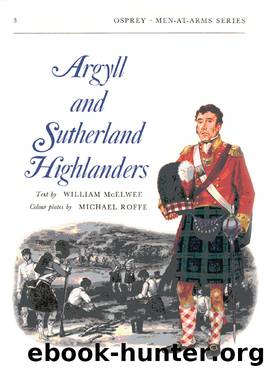Argyll and Sutherland Highlanders by William McElwee

Author:William McElwee
Language: eng
Format: epub
Tags: Argyll and Sutherland Highlanders
ISBN: 9781780967684
Publisher: Bloomsbury Publishing
Published: 2012-03-26T16:00:00+00:00
The Argyll and Sutherland Highlanders, 1881–1918
The Cardwell reforms, intelligently conceived though they were, inevitably imposed some friction and hardships, and demanded immense patience and tolerance from the more junior regiments in the Army List which had only one battalion each and had perforce to amalgamate. In a country like Scotland, where details of tradition, custom and dress mattered more profoundly than any Englishman will ever understand, the strains and difficulties were unavoidably greater; and it was not always easy at first for the 91st and 93rd to work out an equitable compromise.
The 93rd suffered the worse and more irremediable loss. The general territorial regrouping gave Sutherland to the Seaforths as their recruiting area. The counties allotted to the Argyll and Sutherland Highlanders were Argyllshire, Stirling, Clackmannan, Dumbarton, Renfrew and Kinross. Only Argyll could furnish authentic Highlanders; and there had never been enough of them to outnumber the Lowlanders in the single battalion of the 91st. As the years went on, the new regiment was to depend increasingly on Glasgow for its recruits, many of them Irish; and but for its kilt and its very powerful, deeply rooted traditions it would have become indistinguishable from any regiment in the Lowland Brigade. There would be no more marching to church with Bibles under the arm, and no more posting of names in parish churches. In the new regimental title only the word ‘Sutherland’ commemorated the old 93rd. They became Princess Louise’s Argyll and Sutherland Highlanders, and as the years went on this was to mean much more than a merely formal attachment to the Royal Family. The Princess took a close and constant interest in the doings of her regiment which they repaid not just with respect, but with a very real affection. She designed the new regimental badge herself, elegantly combining the Argyll Boar’s Head and the Sutherland Wild Cat, surmounted where suitable by her own cipher and coronet; and the motto of the new regiment was the old 91st ‘Ne obliviscaris’.
In the matter of uniform, however, it was the 93rd who prevailed, which was probably just as well in view of the recent difficulties of the 91st. The Sutherland tartan was practically indistinguishable from the original ‘dark green Campbell tartan with the black line’ in which Lochnell had first raised the 91st. So the anomalous tartan with the red stripe disappeared. The new badger head sporran with its six white tassels and the feathered bonnet both derived essentially from the 93rd. The Kilmarnock bonnet, however, disappeared, and for the future all ranks wore the glengarry whenever they were in trews, for less formal parades, and in place of a forage cap. For the rest there were few problems, since Dress Regulations had always imposed a certain uniformity even on Highland regiments.
Download
This site does not store any files on its server. We only index and link to content provided by other sites. Please contact the content providers to delete copyright contents if any and email us, we'll remove relevant links or contents immediately.
Learning SQL by Alan Beaulieu(6209)
Weapons of Math Destruction by Cathy O'Neil(6142)
Digital Minimalism by Cal Newport;(5663)
iGen by Jean M. Twenge(5366)
Sapiens by Yuval Noah Harari(5293)
The Age of Surveillance Capitalism by Shoshana Zuboff(4209)
Elon Musk by Ashlee Vance(4027)
Thing Explainer by Randall Munroe(3877)
Apollo 8 by Jeffrey Kluger(3635)
Future Crimes by Marc Goodman(3531)
The Science Book (Big Ideas Simply Explained) by DK(3233)
Who Can You Trust? by Rachel Botsman(3086)
Infinite Energy Technologies by Finley Eversole(2938)
I Live in the Future & Here's How It Works by Nick Bilton(2934)
Steve Jobs by Walter Isaacson(2830)
The Innovators: How a Group of Hackers, Geniuses, and Geeks Created the Digital Revolution by Walter Isaacson(2830)
Dawn of the New Everything by Jaron Lanier(2737)
Chernobyl by Serhii Plokhy(2497)
Ben Franklin's Almanac by Candace Fleming(2467)
